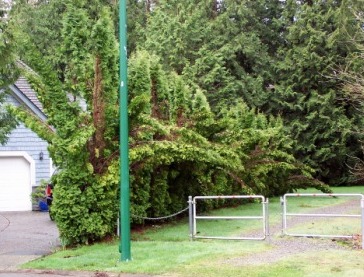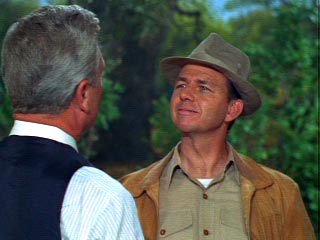I’m in the midst of grading papers for my nursery management class, and something that I’m running across is an incredible number of papers where the students are recommending balanced fertilizers. Why are they doing that? Or maybe an even better question is, what is a balanced fertilizer? A balanced fertilizer is a fertilizer which has three numbers which are about the same, like a 10-10-10. The problem with balanced fertilizers is that they are much higher in phosphorus than what most plants need — at least in relation to the amount of nitrogen and potassium which plants need. Especially here in Minnesota, where there is usually plenty of phosphorus in the ground, this extra phosphorus serves no purpose except to pollute waterways. We have got to break the cycle of just assuming that a balanced fertilizer is the way to go. I get to see a lot of soil tests from old agricultural fields where balanced fertilizers were used for years and years. Usually 10-10-10. What I usually see — with very few exceptions — are phosphorus and potassium levels which are either very high or off the charts entirely. Phosphorus and potassium don’t move readily in the soil while nitrogen does, so every year that you add 10-10-10 in the appropriate amount for your plants needs for nitrogen you’re adding too much phosphorus and potassium. Any extra nitrogen which you add will move through your soil, but P and K will build up year after year (and some will run-off into gutters and drains). So what do I recommend? I like a ratio of about 5-1-2 or 5-1-3 for an N-P-K ratio in a general use fertilizer.
Snow falling on cedars…not always a good thing
Seattle had its first snowfall last week – a mere 3-6″ – and the city shut down. (Yes, those of you in the snowier parts of the midwest and east can laugh…but we’ve got hills. That’s the main problem.) It was unusally cold, so the snow that fell was the light, fluffy kind that I remember from our Buffalo years.
Every year someone writes to ask whether they should remove the snow from their trees and shrubs. Here’s what I suggest:
1) If it’s very cold and the snow is dry and light, I advise leaving the snow on. It serves to insulate tissues from freeze damage.
2) If the snow is wet and heavy (i.e. temperatures are not that cold), you should remove as much as possible. The insulation isn’t necessary, and the weight load can permanently damage trees and shrubs.

This damage can’t be easily repaired; the only alternatives are to cut bent trunks and branches out entirely (no stub cuts!), or to tie them up. Not being into plant bondage, I generally cut bent branches away.
It’s Poinsettia Time…
Love ’em or hate ’em, poinsettias are the number two potted flowering plant produced and sold in the U.S., only (very recently) surpassed by orchids. Especially amazing when you consider the five-week market window. Commercial growers go at poinsettia (“points”) production usually one of two ways: 1) smaller pot, high volume, low margin for mass markets; or 2) larger pot, florist-quality, unusual varieties, for independent garden centers, florists, and other specialty retailers. If you shopped any big box store this past weekend (bless your heart), you saw rolling racks of “doorbuster” deals such a 4.5″ points priced $1.25 or even less. Interestingly, wholesale prices for even the small, high volume product range from $2.05 to $2.88.
Poinsettias from transplant to finish take from 12 to 15 weeks on a greenhouse bench; often require special lighting (or blackout technology), plant growth regulators, and often extra labor to pinch once to encourage branching. Much more expense/inputs than your average 6-pack of petunias, hence the very slim margin for growers of mass market plants. That’s why many growers have taken route “2” – the dee-luxe, gift-type point that appeals to pickier consumers. Big, beefy plants in 8″ to 12″ pots, unusual colors such as pink, plum, and “marbled”, well-pinched to produce lots of showy bracts, wrapped in tastefully decorative pot covers all can command a much higher price point, both by the grower and the retailer. (I don’t have it in me to speak of the bizarre painting/glitter trend at the moment. Maybe I’ll save it for next week.)
Poinsettia breeders are always looking for color breaks, and one of the most “interesting” is this new introduction by Ecke called ‘Polar Bear’:

Pic taken at OFA, the big floriculture trade show, this past July.
There are a couple unusual things about this introduction. One, it comes with a “cause” – Polar Bears International. Ecke’s donating 5% of the sales price (that would be the sale of their rooted liners to finishing growers) to the non-profit conservation society. There’s a whole slew of point-of-purchase tags, pot covers, bows, and signage that goes with, not to mention an informational web site. The other unusual thing is that they insist on calling it “white”. Or at least “creamy”. It’s…not. A lovely lemon-curd yellow, or perhaps off-off-off-off cream. But most polar bears (except for the exceedingly pristine one in their tag photo) aren’t exactly white either. Anyhoo, it’s certainly a good cause, and if “lemon curd” goes with your holiday decor, consider picking up a ‘Polar Bear’!
Maybe common sense isn’t so common after all
I noted in my Sept. 22, 2009 post on the threat posed to ash trees in the Midwest by the emerald ash borer (EAB), and included photos of the famous grove of 500 ash trees surrounding the Gateway Arch in St. Louis. I was in St. Louis that summer for the ASHS meeting and saw that the National Park Service was planting trees from a variety of species around the monument. I assumed at the time that the Park Service was preparing for the eventual loss of the ashes to EAB. Boy, did I get a wrong number.

Last week my former grad student, Sara Tanis, alerted me to an article from the St. Louis Post-Dispatch. The Post-Dispatch reports that with the destruction of the grove of ash trees looming, the National Park Service has contracted with a Los Angeles-based landscape architecture firm to replace the monoculture of ash trees with, I am not making this up, a monoculture of linden trees. I’ve heard that the definition of insanity is to keep doing the same thing and hoping for a different result. Apparently the landscape architects that are drawing up these plans have never seen what Japanese beetles do linden trees. Oh, that’s right; the L.A.’s are in L.A.
The article is available on-line if you can stomach it. http://www.stltoday.com/news/local/metro/article_1e65095d-96ae-507a-acda-574d9f54a73b.html
On the bright side, since this is a Federal project it will likely move forward at glacial speed and will require public input. Here’s hoping the Park Service gets an earful and common sense will prevail.
Candy cane unwrapped
Wow, what a bunch of great guesses this week! All of them are logicial…but only Deb guessed it was a Christmas cactus (actually a Thanksgiving cactus – Schlumbergera truncata) :

In any case, I thought this was a festive way to start the holiday season. (And please, no catty comments about my obsession with plant private parts.)
Candy cane mystery
The decline of Extension and the increased need for science-based information
I hate to be the downer this week, given Bert and Holly’s inspired posts, but reality continues to hit – or bite. The budget crises in Washington state continues to gut higher education, and one of the hardest hit areas at WSU is Extension. Land-grant institutions have a federal mandate to provide Extension services, and this sets WSU and similar universities apart from other state schools. Unfortunately, Extension generates relatively little in terms of outside grants and contracts. Land-grant universities like WSU tend to put their dwindling faculty resources into hiring those who can bring in multi-million dollar grants. And as we’ve bemoaned in past posts, that isn’t in gardening or urban horticulture or arboriculture or any of those great topics that you all love to hear more about.
Let’s look what’s happened with Extension specialists at WSU. Before I came in 2004, the Extension plant pathology specialist had retired. The position was refilled with someone else. The Extension entomology specialist retired last year. His position will be refilled with someone to work with the structural pest control industry (there is some money there). The questions that come from the public are shuffled around among other faculty, who may or may not have some partial appointment in Extension. In any case, the public outreach and education aspect of land grant universities everywhere is taking the back seat to bringing in grant dollars and teaching college students. That means fewer Extension Bulletins published or updated and more reliance on well-funded companies to provide their versions – good or bad – of agricultural sciences.
I’m not going to rail about the idiocy of letting public higher education fail in this country through lack of state funding – I’m sure you can see that for yourselves wherever you live. Instead, I want to point out an effort to gather the remnant state forces to have a national impact.
This year I’ve become associated with eXtension (a national group of Extension personnel) in the Community Horticulture Community of Practice. This is a fledgling effort to construct a national web presence containing relevant, current, science-based information on all things horticultural. If you check out the link above, you can click on Garden Myths, where you’ll find information from…Jeff Gillman and myself.
It’s going to take a long time to get this web resource organized and populated with good information – but it’s a start. If you, or someone you know, is interested in helping, be sure to post a comment or email Karen Jeannette, our intrepid coordinator in Minnesota. (I can provide her email if you are interested.)
“Leave” Them Alone…Adventures in Extension Podcasting
We’re on the topic of communication this week…how can Extension personnel communicate best with their audience/stakeholders. It used to be via racks of Xeroxed “Fact Sheets” at your local Extension office. A few of these are said to still exist, but with states gutting their extension budgets, the costs of printing have become prohibitive. And more critically…where do YOU go for information? A musty file full of handouts? Heck no. Electronic media is tailor-made for extension. It’s virtually free, easily updated, and reaches a vast majority of clients. Bert already covered YouTube, as well as posted the BEST extension video ever, courtesy of Utah State. So I shall not be redundant.
At Virginia Tech, we have some folks utilizing the Power of Podcasts to communicate whatever point they’re trying to make. Dr. Mike Goatley, our Turf Extension Specialist, has done especially well with the technology. He presents practical advice in a very user-friendly package. He nearly always cites relevant research. The information presented in the audio file (MP3) is also available in some sort of text format, whether a fact sheet, script, or PowerPoint handout, often with hot links to the research literature cited. You don’t even need an iPod; just click on the link and your media player of choice will open and play the audio.
For today’s example, I’ve selected one of my favorite Goatley-casts… his guide to lawn leaf management entitled “Leave Them Alone.” Effective, informative, and very convincing…all in 4 minutes. Take a look and listen here…

Mike demonstrates with his mulching mower. The safety glasses are a nice touch. I wouldn’t have thought of that.
Not your father’s extension service
We recently received a question on one of my old posts (Dec. 12, 2009) from a blog reader in Iran (yes, Iran) regarding agricultural extension and asking what’s new in how we disseminate science-based information. There’s no doubt that things have evolved in agricultrual extension over the years. There’s an old joke: Guy walks into a county extension office and the agent is sitting behind his desk, crying. The visitor asks, “What’s the matter?” Agent replies, “My farmer died.”
Hey, I said it was an old joke, I didn’t say it was a funny one. Point is, the days of field extension agents or campus-based extension personnel going out and holding a farmer’s hand are long gone. While some may still think of dim-witted Hank Kimball on “Green Acres” when they think of extension (go to http://www.hulu.com/watch/140842/green-acres-my-husband-the-rooster-renter if you miss the reference), most university extension is going increasingly high tech. I’m sure each on my colleagues can provide several examples of recent extension innovations in there area. I’ll provide one that we have just launched here at Michigan State.

Obviously the single biggest tool we have for outreach and extension is the internet. Recently, Dr. Pascal Nzokou, one of the lead members of our Christmas tree extension team launched the MSU Christmas Tree Channel on youtube http://www.youtube.com/user/MSUChristmasTrees

On the Christmas tree channel members of our extension team provide short (1 ½ – 4 minute) videos on various aspects of production: site selection, species selection, pest management, irrigation, nutrition.

There are several advantages of using youtube for these types of videos. First, uploading the videos is easy and straightforward. We had a professional shoot the videos and do the editing but anyone with a digital video camera can shoot videos and load them on to youtube. For short videos it’s easy to upload videos for viewing even at HD resolution eliminating the ‘Invisibale Gardener expereince’. Once the video is loaded you can send the link out to people you think will be interested or include the link on your website. People may also find your video using the search feature depending on the information you include in the description. Lastly, most people that use the web regularly are used to searching and viewing on youtube so there’s high consumer acceptance.

Trunk teaser untwisted
Good guesses over the weekend on what caused the twisty looking trunk structure in Friday’s puzzle. Here’s a larger photo:

Nancy and Paul both got this one – it’s two trunks fused together. I have no idea whether the production nursery grew two saplings together on purpose or accidentally, but here’s one reason that this tree might be a problem down the road:

This area is ripe for disease, as water will collect in the crotch. In fact, the area is already discolored and could be diseased already.
One thing I hadn’t noticed when I took the top picture were the price tags on the nearby pots. They say it all – W(hy) O(h) W(hy).
Needless to say, I hope, is that you wouldn’t want to buy this plant.
